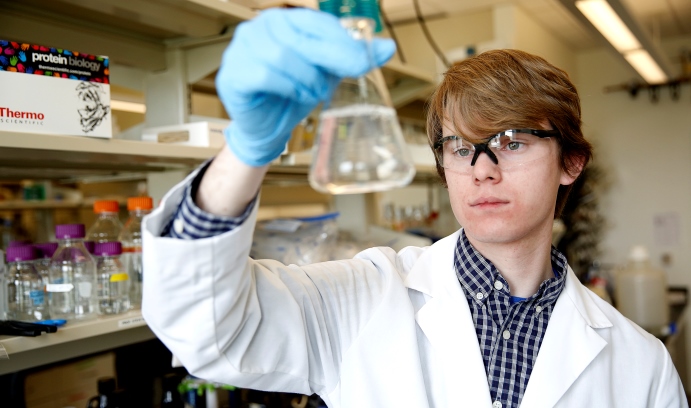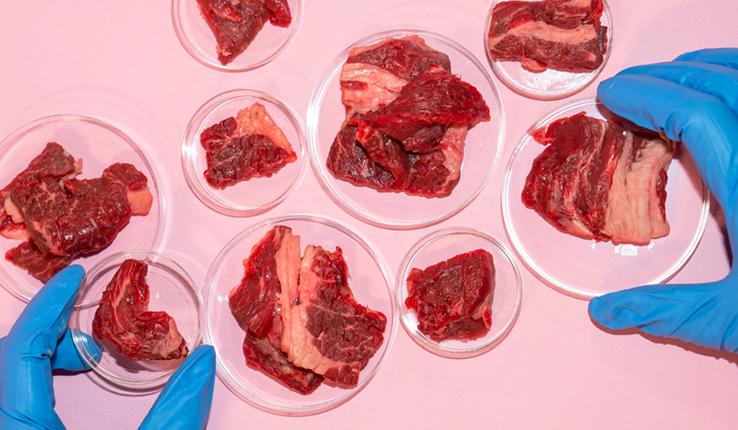Enlisting enzymes to enhance LEDs

Robert Dunleavy ’16 has spent three years working with faculty members and graduate students to produce cadmium sulfide quantum dots with an enzyme from a bacteria.
Robert Dunleavy had just started his sophomore year when he decided he wanted to take part in a research project. He sent an email to Bryan Berger, an assistant professor of chemical and biomolecular engineering, who invited Dunleavy to his lab.
Berger and his colleagues were conducting experiments on tiny semiconductor particles called quantum dots. The optical and electronic properties of QDs make them useful in lasers, light-emitting diodes (LEDs), medical imaging, solar cells and other applications.
Dunleavy joined Berger’s group and began working with cadmium sulfide (CdS), one of the compounds from which QDs are fabricated. The group’s goal was to find a better way of producing CdS quantum dots, which are currently made with toxic chemicals in an expensive process that requires high pressure and temperature.
Three years later, the group has developed a biological method of producing the quantum dots which is cheaper and more environmentally friendly than current methods, and which makes it possible to optimize the QDs’ properties. The group also includes Steve McIntosh, associate professor of chemical and biomolecular engineering; Christopher Kiely, professor of materials science and chemical engineering; and Li Lu, a Ph.D. candidate in materials science and engineering.
With Dunleavy as lead author, the group recently published its results in the Proceedings of the National Academy of Sciences (PNAS), one of the nation’s most prestigious science journals. Their article is titled “Single-enzyme biomineralization of cadmium sulfide nanocrystals with controlled optical properties.” The group’s results have been reported in the science media, including a cover article in the June 2015 issue of Green Chemistry, and in The New York Times and other mainstream media.
For an undergraduate to publish an article in a top science journal, said Berger, is “highly uncommon.” It is also a testament to the research opportunities that Lehigh provides to its students.
“I didn’t publish my first PNAS paper as a lead author until I was a postdoc,” said Berger. “Robert’s achievement, in my opinion, should be celebrated as something attainable for undergraduates at Lehigh and something we should aspire to as faculty and students working together as a team on engineering research.
“I don’t think many U.S. universities would offer this kind of opportunity to an undergraduate to work with faculty and Ph.D. students on a team project that could lead to a high-impact publication as an outcome. This is a unique aspect of Lehigh engineering.”
Attention to detail
Dunleavy, who completed a B.S. in chemical engineering in May, has spent three academic years and two summers working on the quantum dot project. In addition to doing experiments with CdS, he has worked with Kiely and Lu to study the QDs with Lehigh’s aberration-corrected transmission electron microscope (TEM), one of the most powerful instruments of its kind in the world.
“It’s great to have access to the TEM,” he says. “If I attended a school that didn’t have a TEM, I would have to travel to use one.”
Quantum dots measure 1 to 10 nanometers in diameter (1 nm is a billionth of a meter). QDs can absorb and emit light at different wavelengths, that is, if you shine light of one color on them, light of a different color reflects back. The light changes color, says Dunleavy, because of the physics of QDS’ semiconducting lattice and because of the dots’ tiny size. Larger particles measuring hundreds of nm in size lack the optical properties of the smaller particles.
The group sees three applications for its QDs. The first is TV screens with sharper color and features than current TVs. The second is to tag a cancer cell or a protein with a QD; this would enable researchers to use light to track the cell’s progress through the body. The third is more efficient conversion of sunlight to electricity in solar cells.
Dunleavy’s group has developed a biomimetic method of producing quantum dots. The method utilizes biomineralization, a process by which organisms such as bacteria, mollusks and crustaceans produce inorganic materials at room temperature and room pressure. (Click here to see video).
The group has learned to take a bacteria and to isolate and extract from it an enzyme that can produce quantum dots. The enzyme accomplishes this by catalyzing the formation of precursors that bring about mineralization while stimulating the growth of the QDs’ nanocrystals.
“When I started on the project,” says Dunleavy, “Steve and Bryan had already figured out how to extract and isolate the enzyme from bacteria. We’re still working on templating nanocrystal growth in solution. The idea is that a single enzyme that can produce CdS QDs should also play a role in guiding crystal growth to achieve a lattice that is capable of emitting light.”
During his first year with the project, Dunleavy examined enzymes produced by bacteria in hopes of finding “contenders” capable of making QDs. Then, using the aberration-corrected TEM, he worked with Kiely and Lu to characterize each enzyme and compare the properties of the QDs produced by the enzymes with the properties of QDs produced chemically.
“I’ve learned a great deal,” he says. “I’ve learned that I really like research. And I like the atmosphere here. Steve, Bryan and Chris are great advisers. They come from different fields and bring a lot of experience, which is very helpful. I’m going to Cornell in the fall to work on a Ph.D. in chemical engineering.
“I enjoy the investigative side of research, mainly that you are looking [at questions] nobody knows the answers to. To be honest, if I hadn't worked with Bryan, Steve and Chris, I would probably be looking for a job in industry instead of going to graduate school.”
“Robert is highly attentive to detail,” says Berger. “He observes what happens during an experiment that fails or succeeds, and he learns from that to design the next experiment. He reads literature and comes up with a hypothesis and experimental protocols very quickly to test his hypothesis.
“He’s also an equally talented leader and educator—he teaches his lab mates on the techniques he’s developed and really is someone who can lead a project start to finish.
“On this project, Robert has taken our idea that the enzyme was responsible for QD synthesis and has run with it. He designed experiments, expressed and purified the enzyme, did the wet-lab biochemistry, learned the techniques to do QD characterization and saw the project through to completion—the PNAS paper.”
Story by Kurt Pfitzer
Photo and video by Stephanie Veto
Posted on:




